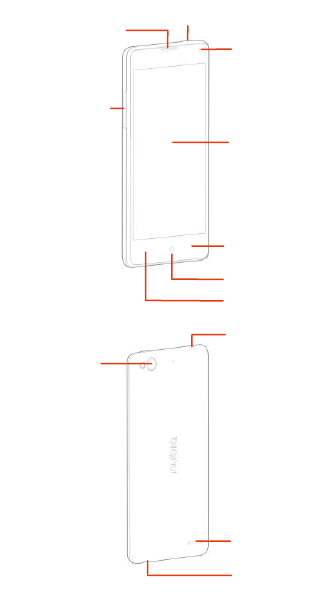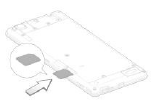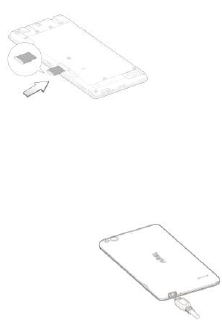ZTE NX405H FDD-LTE Digital Mobile Handset User Manual
ZTE Corporation FDD-LTE Digital Mobile Handset
ZTE >
User manual
NX405H
FDD-LTE Digital Mobile
Handset
User Manual
Copyright Statement
Copyright © 2014 ZTE CORPORATION.
All rights reserved.
No part of this publication may be quoted,
reproduced, translated or used in any form or
by any means, electronic or mechanical,
including photocopying and microfilm,
without the prior written permission of ZTE
Corporation.
ZTE Corporation reserves the right to make
modifications on print errors or update
specifications in this manual without prior
notice.
Trademarks
Android is a trademark of Google, Inc.
The Bluetooth® word and logos are
registered trademarks of Bluetooth SIG, Inc.,
and any use of such marks by ZTE
Corporation is under license.
Wi-Fi is a trademark or a registered
trademark of the Wi-Fi Alliance.
The Micro-SIM card is a tiny SIM card with
the size of 12mm x 15mm, which functions
the same as the larger SIM cards.
All other trademarks remain the property of
their respective owners.
Third Party Applications
During the installation process of some third
party applications, issues of repeated restart
or abnormal use of software might be caused
by incompatibility of the third party
applications rather than the phone itself.
Version 1.0, May 2014
- 1 -
Before you get started
Thank you for choosing the NX405H. We’ll
simply refer to it as the ‘phone’ going forward.
Based on the AndroidTM platform, the phone
supports a quad-core processor with a novel
appearance and a unique user interface,
together bringing you a brand new experience.
If you’d like your phone to live a long and fruitful
life, please read this guide carefully and keep it
for future reference. You never know when you
might need it.
Do Not worry if the pictures we use to
demonstrate the functions of your phone look a
little different from what you see on the screen.
It’s the functions that matter.
If there are any inconsistencies between the
printed guide and the guide found on your
phone as a result of using the “update” function,
please refer to the updated guide found on your
phone.

- 2 -
Earpiece
Touch screen
Menu key
Home key
Back key
Front camera
Volume keys
Power / Lock key
Speaker
Back camera
USB port
Headset jack
Getting to know your
phone

- 3 -
Descriptions of Keys
Keys
Functions
Power/Lock
key
Press and hold to turn phone
on/off, change the sound setting
to silent or sound, or to set to
Airplane mode.
Press to switch your phone to
Sleep Mode.
Press to wake up your phone.
Home key
Tap to return to the main home
screen from any application or
screen .
Tap and hold to see recently used
applications.
Menu key
Tap to see the options for the
current screen.
Back key
Tap to go to the previous screen.
Volume
keys
Adjust the volume. Press & hold
the UP key to adjust to the
maximum volume, and press &
hold the DOWN key to adjust to
silent mode.

- 4 -
Getting started
Inserting and removing the
SIM card
You must insert a valid SIM card into your
phone before use. All information about
establishing a network connection, together
with other important information (ex. Contacts),
is stored on the SIM card.
1. Turn off your
phone.
2. Remove the
back cover.
3. Slide the SIM
card into the SIM/UIM card slot and replace
the back cover.
Turn off your phone before taking out the SIM
card.
Note: Only micro-SIM cards may be used.
Inserting a memory card
1. Remove the back cover.
2. Push tightly until the card is installed in the
correct position and replace the back cover.

- 5 -
Charging the battery
When you first unpack the phone, the battery
will only be partially charged. Please use the
remaining capacity of the battery before you
recharge it for the first
time. To ensure the
battery is always in its
best condition, please
charge the battery for
8 hours the first time
and recharge it for at least 2 hours each time
afterwards.
1. Connect the charger with the phone through
the USB port, and plug the charger into a
standard power socket.
2. Please unplug the charger from the power
socket and from your phone after the
charging is completed.
Tips:
To charge the battery, you can also
connect your phone to the PC through the
USB cable.
During the process of charging, your
phone and charger may generally become
hot.
- 6 -
Power on/off
Powering on
Press & hold the Power key to turn on your
phone.
Powering off
To turn it off, press and hold the Power key to
open the options menu, and then select Power
off.
Tips:
If your SIM card has enabled PIN verification,
you will need to enter the correct PIN when you
turn on your phone.
The PUK code is required to unlock the phone if
you have incorrectly entered the PIN three
consecutive times. Please contact your network
operator to get your PUK code.
If your phone cannot be turned off normally,
please press & hold the Power key for more
than 10 seconds to forcefully turn off your phone,
and then restart it.
- 7 -
Basic Operation
Screen control
You can control your phone through a series of
operations on the screen.
Tap: Tap once on an item on the screen to
select/open it.
Slide to scroll: Slide your fingers on the
screen to move through the screen.
Press & hold: Press your finger down and
leave it there for a few seconds to open a
menu specific to what you're doing.
Drag: Drag an item on the screen to
perform certain operations.
Pinch or stretch: In some applications
(e.g., Gallery, Browser), touch the screen
with two or more fingers, and then pinch
your fingers together on the screen or
stretch them apart to zoom in or out.
Rotate: In most screens, rotate your
phone sideways to switch the screen from
portrait mode to landscape mode.
Home screen
The home screen appears when the phone is in
idle mode. On the home screen, you can check
the status of the phone and access applications.
Extend home screen
The home screen can be extended to exceed the
width of the screen to provide more space for
newly added applications, shortcuts, widgets, etc.

- 8 -
Slide to scroll through the home screen by
swiping to the left or right side of the home
screen.
Tap a small dot at the lower part of the screen
to directly move to the corresponding screen.
Press & hold the small dot area and drag it to
navigate quickly.
Add or move screen on home screen
Pinch your fingers together on the home screen
to display as thumbnails, and tap a thumbnail to
enter the corresponding screen.
Tap to add a new screen and tap to
set the current screen as main home screen.
Self-defined function bar
There are four icons at the bottom of the screen.
You can replace these icons with applications
or shortcuts that you access most frequently.
1. Press & hold an icon at the function bar and
drag it to the area outside the function bar.
2. Press & hold the icon you want to replace it
with, and then drag it to the empty area in the
function bar.
Move icons on home screen
Press & hold the icon you want to move then
drag it to your desired position on the screen
and release it.
Press & hold an icon with one finger and scroll
the screen with another finger to put it on a
different screen.

- 9 -
Delete icons on home screen
Press & hold the app or widget icon to display
at the top of the screen, then drag and
drop it there to delete it.
Change wallpaper
Press & hold an empty area on the home
screen to open the menu “Desktop Edit”, tap
“Wallpapers” and choose a wallpaper.
Lock and unlock the screen
Lock the screen
Press the Power key to lock the screen. The
phone will automatically lock after inactivity for
a short period of time.
Unlock the screen
1. Press the Power key to turn on the LCD
screen.
2. Press & hold the icon at the lower part of
the screen, then drag it to “Unlock” to unlock
the screen. Drag up to “Unlock to Camera” to
directly open the Camera application.
Change screen lock method
1. At the home screen, press the Menu key >
“System settings” > “Security & location” >
“Screen lock”.
2. Choose the screen lock method.
- 10 -
Access recently used
applications
Press & hold the Home key to display the list of
applications you’ve recently accessed. Tap the
application you want to open. Slide your fingers
up on an application thumbnail to delete it from
the list.
Tap the round icon at the lower part of the
screen to clear the list of applications you’ve
recently accessed.
USB mass storage
1. Connect your phone to the PC with a USB
cable.
2. Bring down the Notification menu on the
phone and tap “USB connected”.
3. Tap “USB mass storage” on the phone.
- 11 -
Certification information (SAR)
This mobile device meets guidelines for
exposure to radio waves.
Your mobile device is a radio transmitter and
receiver. It is designed not to exceed the limits
for exposure to radio waves recommended by
international guidelines. These guidelines were
developed by the independent scientific
organization ICNIRP and include safety
margins designed to assure the protection of all
persons, regardless of age and health.
The exposure guidelines for mobile devices
employ a unit of measurement known as the
Specific Absorption Rate or SAR. The SAR limit
stated in the ICNIRP guidelines is 1.6
watts/kilogram (W/kg) averaged over 1 gram of
tissue. Tests for SAR are conducted using
standard operating positions with the device
transmitting at its highest certified power level
in all tested frequency bands. The actual SAR
level of an operating device can be below the
maximum value because the device is
designed to use only the power required to
reach the network. That amount changes
depending on a number of factors such as how
close you are to a network base station.
Use of device accessories and enhancements
may result in different SAR values. SAR values
may vary depending on national reporting and
testing requirements and the network band.
Your mobile device is also designed to meet the
requirements for exposure to radio waves

- 12 -
established by the Federal Communications
Commission (USA) and Industry Canada. These
requirements set a SAR limit of 1.6 W/kg
averaged over one gram of tissue. The highest
SAR value reported under this standard during
product certification for use at the head is 0.65
W/Kg and when properly worn on the body is
1.19 W/Kg.
While there may be differences between the
SAR levels of individual NX405H phones and
at various positions, they all meet the
government requirement.
The FCC has granted an Equipment
Authorization for this model phone with all
reported SAR levels evaluated as in
compliance with the FCC RF exposure
guidelines. SAR information on this model
phone is on file with the FCC and can be found
under the Display Grant section of
www.fcc.gov/oet/ea/fccid after searching on
FCC ID: SRQ-NX405H.
For body worn operation, this phone has been
tested and meets the FCC RF exposure
guidelines for use with an accessory that
contains no metal and that positions the
handset a minimum of 1.0 cm from the body.
Use of other accessories may not ensure
compliance with FCC RF exposure guidelines. If
you do not use a body-worn accessory and are
not holding the phone at the ear, position the
handset a minimum of 1.0 cm from your body
when the phone is switched on.
- 13 -
FCC compliance information
This mobile phone complies with part 15 of the
FCC Rules. Operation is subject to the
following two conditions: (1) This device may
not cause harmful interference, and (2) this
device must accept any interference received,
including interference that may cause
undesired operation.
This mobile phone has been tested and found
to comply with the limits for a Class B digital
device, pursuant to Part 15 of the FCC Rules.
These limits are designed to provide
reasonable protection against harmful
interference in a residential installation. This
equipment generates, uses and can radiated
radio frequency energy and, if not installed
and used in accordance with the instructions,
may cause harmful interference to radio
communications. However, there is no
guarantee that interference will not occur in a
particular installation If this equipment does
cause harmful interference to radio or
television reception, which can be determined
by turning the equipment off and on, the user
is encouraged to try to correct the interference
by one or more of the following measures:
-Reorient or relocate the receiving antenna.
-Increase the separation between the
equipment and receiver.
-Connect the equipment into an outlet on a
circuit different from that to which the receiver
- 14 -
is connected.
-Consult the dealer or an experienced
radio/TV technician for help.
FCC Note:
Caution: Changes or modifications not
expressly approved by the party responsible
for compliance could void the user‘s authority
to operate the equipment.
Hearing Aid Compatibility (HAC) regulations
for Mobile phones
In 2003, the FCC adopted rules to make
digital wireless telephones compatible with
hearing aids and cochlear implants. Although
analog wireless phones do not usually cause
interference with hearing aids or cochlear
implants, digital wireless phones sometimes
do because of electromagnetic energy emitted
by the phone's antenna, backlight, or other
components. Your phone is compliant with
FCC HAC regulations (ANSI C63.19- 2011).
While some wireless phones are used near
some hearing devices (hearing aids and
cochlear implants), users may detect a
buzzing, humming, or whining noise. Some
hearing devices are more immune than others
to this interference noise and phones also
vary in the amount of interference they
generate. The wireless telephone industry has
developed a rating system for wireless phones
to assist hearing device users in finding
- 15 -
phones that may be compatible with their
hearing devices. Not all phones have been
rated. Phones that are rated have the rating
on their box or a label located on the box. The
ratings are not guarantees. Results will vary
depending on the user's hearing device and
hearing loss. If your hearing device happens
to be vulnerable to interference, you may not
be able to use a rated phone successfully.
Trying out the phone with your hearing device
is the best way to evaluate it for your personal
needs.
This phone has been tested and rated for use
with hearing aids for some of the wireless
technologies that it uses. However, there may
be some newer wireless technologies used in
this phone that have not been tested yet for
use with hearing aids. It is important to try the
different features of this phone thoroughly and
in different locations, using your hearing aid or
cochlear implant, to determine if you hear any
interfering noise. Consult your service
provider or the manufacturer of this phone for
information on hearing aid compatibility. If you
have questions about return or exchange
policies, consult your service provider or
phone retailer.
M-Ratings: Phones rated M3 or M4 meet FCC
requirements and are likely to generate less
interference to hearing devices than phones
that are not labeled. M4 is the better/higher of
the two ratings.
- 16 -
T-Ratings: Phones rated T3 or T4 meet FCC
requirements and are likely to be more usable
with a hearing device’s telecoil (“T Switch” or
“Telephone Switch”) than unrated phones. T4
is the better/ higher of the two ratings. (Note
that not all hearing devices have telecoils in
them.)
Your phone meets the M3/T4 level rating.
Hearing devices may also be rated. Your
hearing device manufacturer or hearing health
professional may help you find this rating. For
more information about FCC Hearing Aid
Compatibility, please go to
http://www.fcc.gov/cgb/dro.